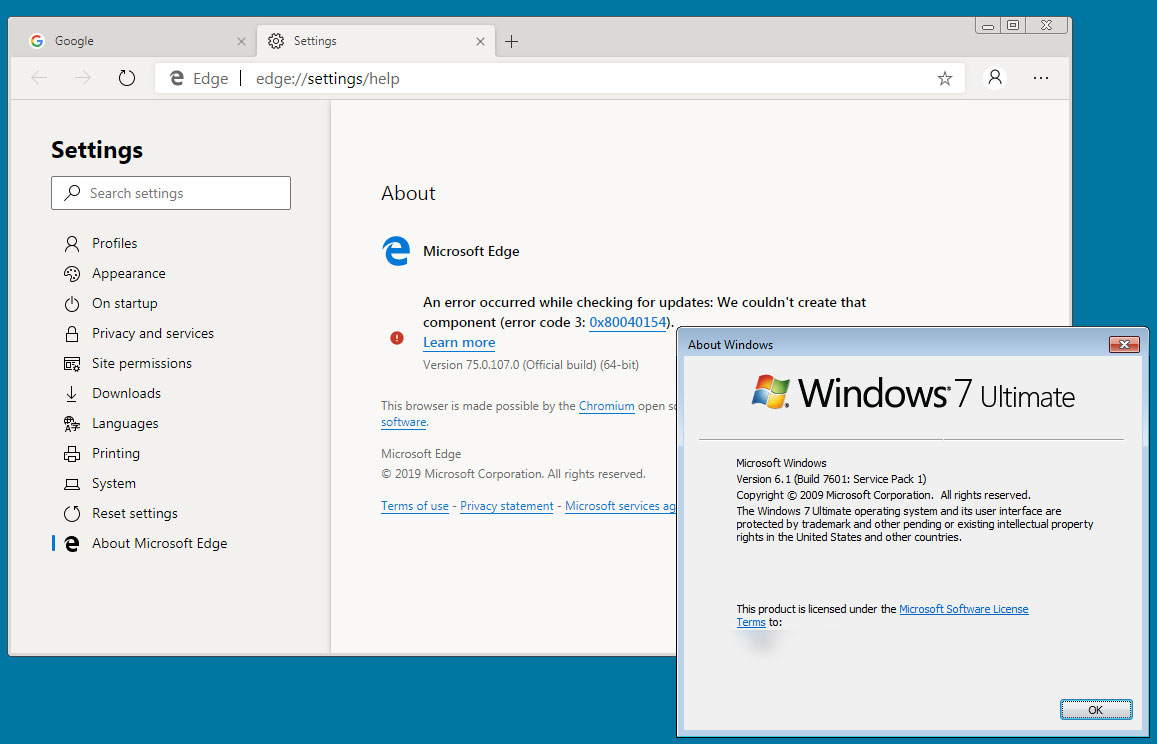The migration of Microsoft Edge from EdgeHTML to Chromium allowed Microsoft to make the browser a cross-platform application, so instead of being limited to just Windows 10, it’s also available on other Windows and non-Windows platforms.
So right now, the Chromium-powered Microsoft Edge can be installed on Windows 7, Windows 8, Windows 8.1, Windows 10, and macOS, with a Linux version also on its way without a specific ETA.
As far as Windows 7 users are concerned, the browser will be supported until July 2021, so if you’re still running the 2009 operating system, you can continue using Microsoft Edge on your device for one more year.

Microsoft Edge landed on Windows 7 earlier this year as a manual download, with the dedicated installers allowing users to install the browser just like any other application.
More recently, however, Microsoft has also started the automatic rollout of Microsoft Edge to Windows 7 devices via Windows Update. In other words, those running Windows 7 are getting the browser no matter they like it or not, and it’s all thanks to update KB4567409.
Jun 22, 2020 Microsoft has started rolling out Microsoft Edge to all non-Enterprise Windows 7 users via Windows Update. Windows 7 reached the end of support on January 14, 2020, and Microsoft stated that they. Microsoft Edge on Mac, Linux, and Windows 7 As Microsoft Edge has transitioned to using Chromium, it has also broken free of Windows 10 exclusivity. If you’re using a Mac, Linux, or Windows 7. Download Microsoft Edge - Enjoy extended battery life when browsing unplugged and get to what you are looking for quickly. Microsoft Edge is the safe browser designed for Windows 10.
But as compared to Windows 10, where the new Edge becomes the default browser on systems running this operating system, the automatic update on Windows 7 comes with a different set of changes.
First and foremost, the update is only aimed at consumer versions of Windows 7.
“This update is not intended to target Enterprise devices. Specifically, this update targets devices that run Windows 7 SP1 or later versions and Windows 8.1 or later versions that are either Home, Professional, Ultimate, Starter, or Core editions. Devices that run these editions on Active Directory or Azure Active Directory domain are also excluded from this automatic update,” Microsoft explains.
Then, once the new browser is installed with this update, its icon is automatically pinned to the taskbar, while a shortcut is added to the desktop. If you previously installed the new Microsoft Edge manually on your Windows 7 device, this update replaces the shortcut, thus pointing to you to this new version.
What’s important to know is that Microsoft Edge on Windows 7 isn’t supposed to replace Internet Explorer – as compared to Windows 10, Windows 7 shipped with Internet Explorer as the default browser, but Microsoft Edge, on the other hand, isn’t supposed to completely replace IE. So Microsoft Edge lands on Windows 7 without this goal in mind, but to allow users to choose what browser they want to stick with going forward.
And this is why Microsoft Edge also isn’t configured as the default browser on the device, so if you’re running Google Chrome or Mozilla Firefox, no change is going to take place on the computer. This means that while the new Microsoft Edge is installed on the device, you can continue using whatever browser you like just like before.
And of course, if you don’t like Edge, you can just remove the taskbar icon and the desktop shortcut and then forget it exists. Needless to say, you can also uninstall the browser completely and also remove the update if you want to return to the original configuration.
Windows 7 no longer receives updates since January this year when it officially reached the end of support, so it’s now another abandoned platform, with Microsoft recommending everyone to upgrade to Windows 10. In other words, this is pretty much the only update that you’re going to get, as Windows 7 is otherwise an outdated operating system that you should no longer use going forward.
-->This article describes the supported operating systems that apply to Microsoft Edge.
Note
This article applies to the Microsoft Edge versions 77 and higher for the desktop.
Supported Operating Systems for Microsoft Edge
Note
Product functionality and feature availability may vary on older operating systems. To ensure that Microsoft Edge installs correctly, use the latest version of any operating system specified below. This guidance includes the latest cumulative update, as applicable.
Microsoft Edge follows the Modern Lifecycle Policy and is supported on the following operating systems.
Windows Client
- Windows 7 **
- Windows 8.1
- Windows 10 SAC 1709 and later ***
- Windows 10 Enterprise 2015 LTSC
- Windows 10 Enterprise 2016 LTSC
- Windows 10 Enterprise 2019 LTSC
- Windows 10 Enterprise multi-session
- Windows 10 IoT Enterprise SAC ****
- Windows 10 IoT Enterprise 2019 LTSC ****
Windows Server
- Windows Server 2008 R2 **
- Windows Server 2012
- Windows Server 2012 R2
- Windows Server 2016 (LTSC)
- Windows Server 2019 (LTSC)
- Windows Server (SAC)
Important
** We will continue to support Microsoft Edge on Windows 7 and Windows Server 2008 R2 until January 15, 2022. These operating systems are out of support and Microsoft recommends you move to a supported operating system such as Windows 10. While Microsoft Edge helps keep you more secure on the web, your PC may still be vulnerable to security risks. In order for IE mode to be supported on these operating systems the devices will need to have the Extended Security Updates for Windows 7. Without the Windows 7 Extended Security updates Internet Explorer functionality will be vulnerable to security risks. Additionally, IE mode functionality may cease to work without the continued servicing through the extended security updates.
*** In the same fashion as above, for Windows 10 SAC releases that are out of support but Microsoft Edge is supported it is recommended to upgrade to a supported Win10 SAC release as soon as possible to remain secure. Microsoft Edge being supported in this state should be considered a temporary bridge to getting to a supported OS state.
**** The Microsoft Edge OPK is available on MOO for IoT OEMs to preinstall and distribute as part of their Windows 10 IoT Enterprise based solution.
macOS
- Sierra (10.12) and later
iOS
Microsoft Edge for iPad® and iPhone® requires iOS 11.0 or later. Microsoft Edge for iPad Pro™ requires iOS 11.0 or later. Microsoft Edge is supported on the two most recent versions of iOS. When a new version of iOS is released, the Microsoft Edge Operating System requirement becomes the then-current two most recent versions: the new version of iOS and the previous version.
Microsoft Edge Windows 7 64 Bit Offline Installer

Android
Microsoft Edge for Android can be installed on tablets and phones that meet the following criteria: devices running Android KitKat 4.4 or later with an ARM-based processor.
New Microsoft Edge Download For Windows 10
Apple Silicon Macs
Microsoft Edge native support as of Stable version 88 for Apple Silicon Macs.
Chromebooks
Microsoft Edge does not support Chromebooks.

Recent changes
- 12/17/2020 - Microsoft Edge support on Windows 7 and Windows Server 2008 R2 extended to January 15, 2022.
- 01/28/2021 - Microsoft Edge support for Apple Silicon Macs.
Microsoft Edge Update For Windows 7
See also
